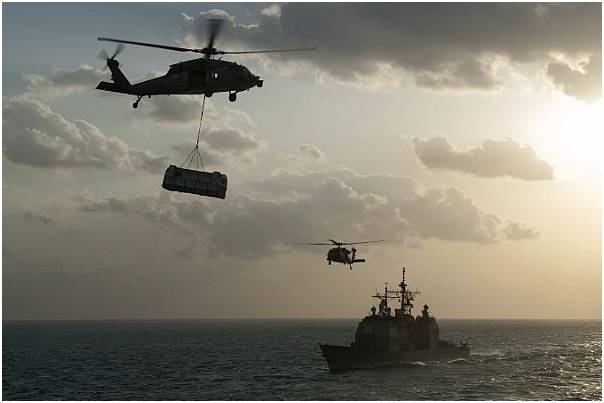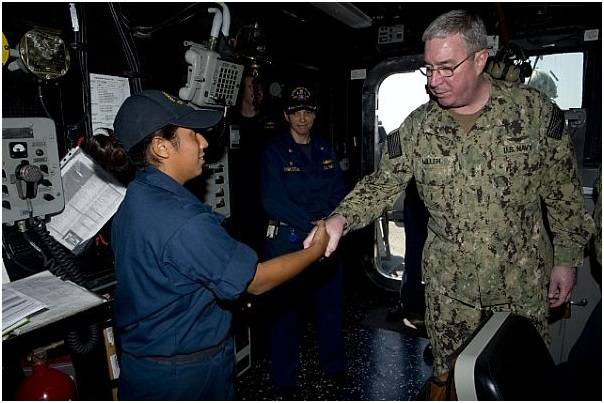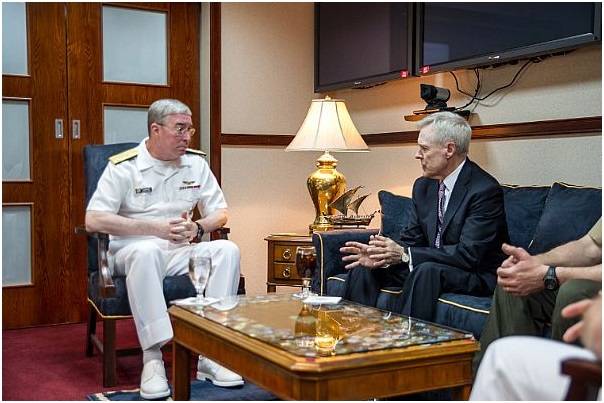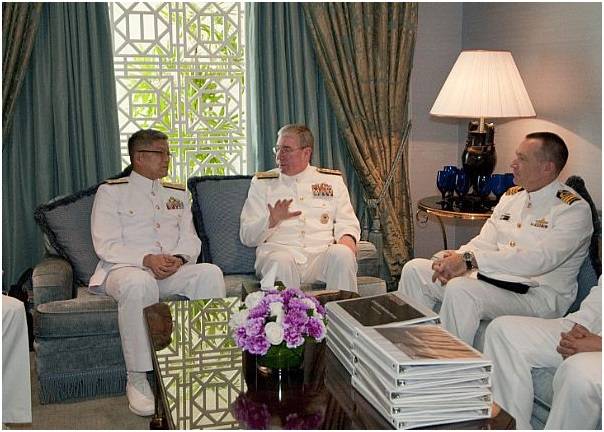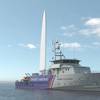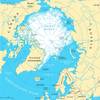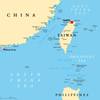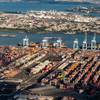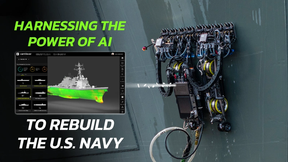Middle East Maritime Security: Cooperation is the Key Vital
Vice Adm. John Miller, U.S. Navy, commander, U.S. Naval Forces Central Command (NAVCENT), U.S. 5th Fleet, Combined Maritime Forces (CMF) , spoke to delegates attending the IQPC Offshore Patrol Vessel (OPV) Middle East 2013 conference just after participating in the 8th International Institute For Strategic Studies (IISS) Manama Dialogue to discuss the development and implementation of regional security and provided a platform for leaders from more than 30 countries to engage in inter-governmental dialogue on sensitive regional issues.
At OPV Middle East 2013, attended by members of navies and coast guards from throughout the Middle East and the world, Miller stressed that partnerships and teamwork are vital to meet the challenge of evolving threats in the region. But, he asked the audience, “What we are deterring ourselves from?”
Iran looms large
As the U.S. Navy’s maritime force commander, Miller began his remarks addressing the conventional regional maritime threat posed by Iran. “Iran still presents a threat in the maritime environment which is what we refer to as a stacked threat,” he said. “Even if they ultimately decide not to develop nuclear weapons, they still have three Kilo submarines; they have a number of midget submarines; they have a credible cruise missile defense program; they have an credible ballistic missile program, they have torpedo and missile boats; they have a rather substantial mine inventory; they have an air defense system; and they have an air force. And so, even if they don’t develop any nuclear weapons, they still have the capability to project substantial power in the maritime battle space—and will for the foreseeable future.”
Miller was clear, “there is going to be an ongoing and a continuing requirement to make sure that we are a presence in the environment so that we can provide deterrent effect to the point that we can assure security and stability in the gulf and certainly through the Strait of Hormuz.”
Anticipating a decline in U.S. presence in Afghanistan through 2014, Miller reminded the attendees that maritime forces still have a role in the skies above the combat zone. “I think it’s a fairly lesser-known fact that from the maritime component standpoint we continue to support Operation Enduring Freedom. The USS Truman is off the Makran coast [of Pakistan] right now, and they fly somewhere between 20 and 28 sorties a day in support of the mission in Afghanistan. When we fly in support of that mission, we do provide about one third of the air support in support of the coalition troops that are on the ground in Afghanistan.”
Piracy end state?
Miller said there hasn’t been a successful piracy attack since 2012, but there have been four piracy attempts since the first of October, and so the piracy mission is not completed. “We have had success in the Somali basin and we have not had a successful attack in almost 19 months. But one need only look at the experience of the Strait of Malacca when a consortium of nations and coalitions of nations tried to gather several years ago to eradicate piracy in the Strait of Malacca, they were very successful. Then they disbanded and stopped their efforts because they thought they had eradicated piracy and piracy came right back again and they started all over again, just as if they’d never started in the first place. So when you reach an end state on piracy, you’re not sure that you reach an end state on piracy. It’s just a matter of when.”
Miller points to partnerships and coalitions that have been the key to success in regional maritime operations, including the European Union (EU) task force; a NATO task force and Combined Task Force (CTF) 151, which is part of CMF.
“One would wonder why you need three task forces. What does that do us? We’ve had conversations about whether or not we should combine all that and have one task force,” Miller said.
“If you’re a European Union member and you have an allocation to provide maritime support to the European Union, one of the ways that you could provide that support is by providing a ship to the counter piracy missions of the European Union effort. If you’re a member of NATO, you’re under obligation to provide ships to the NATO missions and one of the ways you can do it is to provide ships to the counter piracy mission. That’s very popular in capitals all around the world because no one likes piracy. If you want to contribute to the counter piracy mission, and you’re not a member of the European Union and you’re not a member of NATO, then you can join Task Force 151. For a number of years the Japanese were a nation that would provide ships into the Horn of Africa and they would support as an independent nation of the counter piracy mission. And on the 8th of December, yesterday, they asked to join Task Force 151—a significant event for the Japanese. This is the first time since World War II and since the establishment of their new constitution, that they have joined an international maritime task force. And so that is very significant and we are very proud to have them on board.”
Miller explained that China, India and Russia, who each contribute independently to the counter-piracy effort, have expressed increased desire to expand their interaction with the task forces. “China routinely provides a 3-ship surface action group in the Somali basin—they operate independently—and they indicated at the SHADE (Shared Early Warning and Deconfliction) conference that they are interested in increased cooperation with the three different task forces that are conducting counter piracy operations”.
“So the independent nations are looking for increased cooperation, which will only enhance counter piracy efforts in the region,” he said.
Suez a security success
The United States is a heavy user of the Suez Canal, Miller said. “In any given year [the United States Navy has] somewhere between 150 and 200 ship transit through the canal. So access to the canal is important to us; and security of the canal is of course of the utmost importance to us. One of the things I’d like to congratulate the Egyptians for is the fact that since the overthrow of President Mubarak up until this day, including and especially after the events of July the 3rd, access to the canal is remaining consistently better.”
“Security of the canal zone, which is entirely under the purview of the Egyptians, has remained rock solid,” Miller said. “My hat goes off to the Egyptians for the excellent job that they continue to do.”
“What happens in the Bab el-Mandeb Strait, and the challenges and opportunities in Yemen, are important to us. The head of the Yemeni coast guard accepted our invitation to become the 30th member of the Combined Maritime Forces. So, Yemen continues to strive to be part of the solution and part of the maritime security solution throughout the entire region.
Syrian instability
“The instability that we continue to see in Syria leads to instability throughout the region, in particular in Jordan and Lebanon, which is of concern to us, including those of us who are interested in the maritime environment,” he said.
Miller mentioned he is concerned about the tie between Iran, Syria, and Lebanese Hezbollah, noting that instability in Syria potentially leads to the instability of the Arabian Gulf.
“How do the Iranians react to either perceived gains or losses of the Assad regime in Syria?” he said.“One of the things that I found interesting last weekend as I watched the plenary sessions at the Manama Dialogue, is that almost every topic, regardless of what it might be, in some way tied to Syria. And so for all of us, including those of us who are interested in the maritime environment, what happens in Syria, has an effect on what happens throughout the region and in the maritime.”
According to Miller, there isan average of about 17,000 Sailors in the NAVCENT AOR–10,000 of them at sea and another 7,000 on shore to support those who are at sea. NAVCENT operates about 45 surface units at any given time, including one Carrier Strike Group (CSG) and one Amphibious Ready Group (ARG) with 2500 Marines in the embarked Marine Expeditionary Unit. There are about 130 aircraft in the theater – some are based on the aircraft carrier, but another 25 that are land-based, including maritime patrol aircraft.
Miller says he’s aware of the talk about the U.S. potentially achieving energy independence. “It’s important to remember that in 1948, when we first established a presence ashore here, we did so because we had ships at sea here on a permanent basis. At that time the United States was the largest producer of oil in the world, and the United States was the largest exporter of oil in the world. Today, 40% of the world’s oil–about 18 million barrels–transits by sea and passes through the Strait of Hormuz every day. Japan receives 85 percent of its oil from the Gulf; China receives 7 percent of its oil from the Gulf. So regardless of how much oil the United States produces, if the flow of oil through the Strait of Hormuz is impeded, it’s going to have an immediate impact on the economies of Japan and China, which means it’s going to have an immediate impact on the global economy. Oil is not a national asset; oil is not a regional asset; oil is a global asset. Whether oil flows in from the gulf, or from the west coast of Africa, or from Brazil, or from the United States or from North America, anywhere its movement is impeded will have an impact across the globe; an immediate impact. Neither the United States–nor any nation–can afford to ignore any part of the world where oil is produced. Nor can we afford to accept any part of the world where the free flow of commerce is not an established and given fact. Any ship from any nation should be able to leave from port and expect that it can go to any other port in the world, and do so safely, and then return home safely.
Forward presence together
Miller echoes Chief of Naval Operations Adm. Jonathan Greenert’s three tenets of “warfighting first, operate forward, and be ready,” and specifically the need to operate forward. “You can’t influence if you’re not here. Clearly the U.S. Navy is committed to doing that. We’ve had ‘boots on the ground,’ if you will, in Bahrain since 1948. We have been owners so to speak of the base and the facility in Juffair since 1972. We have about a billion and a half dollars of infrastructure investment in that facility right now. We have another half a billion dollars scheduled over the next couple of years in that facility as we transition it to be able to take on a littoral combat ship and some other replacement ships and hardware that are coming online. So we have a commitment to the region and a commitment to staying. We do about 25 exercises with the GCC nations each year, and we do a total of about 64 named exercises throughout the region, from Alexandria, Egypt, to the east coast of Pakistan. Operating with
our partners has a deterrent effect and it’s extremely important that we continue to do that.
“We think our operations deter and they’re designed to deter, that’s the whole point of them,” Miller said. “And we think we influence the maritime environment day-to-day.”
Miller said it’s important that we continue to train and fight as a joint force, and as a combined force. He executes this vision every day as he oversees the CMF, a coalition of nations operating three distinct task forces to ensure maritime security in the region. “When I took command of the Combined Maritime Forces 18 months ago, we had 26 participating nations. Today we have 30 with the addition of the Yemeni coast guard. We have five other nations that are actively considering joining the CMF, including key nations from South America. If either of those nations from South America actively joins the CMF, we will have nations from every continent on the globe as part of our combined maritime force.”
NAVCENT has seen great success in conducting complex multi-lateral exercises. “We’ve held two international mine countermeasures exercises, the first one in 2012 when we had 33 nations participate. Our second exercise, IMCMEX 13, was held in 2013, when we had 40 nations participate. Our next exercise is scheduled for November of 2014. We’ve sent out the invitations for that event to 69 different nations. In the 2013 exercise, we had 35 ships, 13 unmanned underwater vehicles, and over a hundred mine countermeasures diversparticipat in the exercise. We exercised new technologies and we exercised the ability to test communications and command and control across a wide spectrum. In addition to the exercise itself, we held a Maritime Infrastructure and Protection Symposium, and we conducted maritime security operations. As we all know, maritime security operations begin at the point of origin and extend all the way to the point of delivery. IMCMEX 2014 promises to do all of that and more–more robust training, better leveraging of technology, and much more robust command and control. To accomplish this we must continue to leverage partnership capacity and capability in a way that we can truly integrate with other nations. It’s not just more stuff or better stuff; it’s more and better stuff that can operate with other nations. We prove that with exercises and through operations on a day-to-day basis. This really is the future for all of us. It’s being able to talk–getting to the right frequency, and being able to communicate in a secure way–not simply knowing the chain of command, but being able to communicate up and down that chain of command. It’s being able to develop a secure, recognized maritime picture that’s the same for the U.S. Navy’s Maritime Operations Center in Bahrain as it is for the Bahraini navy and coast guard; and to have that same picture for Kuwait and the United Arab Emirates; and eventually the full picture on the Red Sea that includes the Egyptian navy, so all of us know what’s going on; all of us have the same picture; and when we go to make decisions we can make them as partners and have the best possible outcome,” Miller said.
Where other major alliances have a thick policy manual that requires unanimous agreement on all issues, Miller says CMF runs on a paragraph. “It says, basically, ‘come on, join us, if you want to, glad to have you, and whatever your national authorities are we’re going to respect those.’ And if we ask you to do something that exceeds your national authorities, just tell us, and then we’ll do something different.”
CMF runs on CENTRIX
A relatively simple communications network called CENTRIX allows partner nations to communicate at sea.
The Combined Enterprise Regional Information Exchange system enables commands at sea to communicate via chat and pass data and plans via email. Although some special equipment may need to be installed—and depending on the level of classification, the U.S. may provide personnel to partner navies to operate the equipment—but generally CENTRIX permits secure communications capabilities while sharing a common operational picture of ship locations, especially helpful in coordinating multi-national counter-piracy missions.








